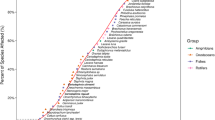Abstract
Neon tetras Paracheirodon innesi were exposed to various species of copper during exposures to evaluate the bioavailability of free copper (0 to 2 mg/l), copper apparently complexed to humic substances (0 to 160 mg/l), and copper adsorbed on kaolin clays (0 to 182 mg/l). The results of the experiments demonstrated that free copper is the most bioavailable form. Both humic substances and kaolin clay particulates reduced copper bioavailability to the fish. However, fish accumulated a fraction of copper complexed to humic substances and part of copper adsorbed on kaolin clays.
Similar content being viewed by others
References
Benson, W.H., Alberts, J.J., Allen, H.E. and Hunt, C.D. (1994). Synopsis of discussion session on the bioavailability of inorganic contaminants. In J.L. Hamelink, P.F. Landrum, H.L. Bergman, and W.H. Benson (eds.), Bioavailability: Physical, Chemical, and Biological Interactions, pp. 63-71. Boca Raton, FL: Lewis.
Chen, J.S. and Tao, S. (1990). Environmental Geochemistry. Beijing: China Oceanography Press.
Cope, W.G., Wiener, J.G. and Steingraeber, M.T. (1996). Test system for exposing fish to resuspended, contaminated sediment. Environmental Pollution 91, 177-182.
Giesy, J.P., Jr., Leversee, G.J. and Williams, D.R. (1977). Effects of naturally occurring aquatic organic fractions on cadmium toxicity to Simocephalus serrulatus (Daphnidae) and Gambusia affinis (Poeciliidae). Water Res. 11, 1013-1020.
Hamilton, S.J. and Buhl, K.J. (1997). Hazard assessment of inorganics, individually and in mixtures, to two endangered fish in the San Juan River, New Mexico. Environ. Toxicol. and Water Qual. 12, 195-209.
Hollis, L., Muench, L. and Playle, R.C. (1997). Influence of dissolved organic matter on copper binding, and calcium on cadmium binding, by gills of rainbow trout. J. Fish Biol. 50, 703-720.
Lemaire, G.S., Lemaire, P. and Pulsford, A.L. (1995). Effects of cadmium and benzo(a)pyrene on the immune system, gill ATPase and EROD activity of European sea bass Dicentrarchus labrax. Aquatic Toxicol. (Amsterdam) 31, 297-313.
Newman, M.C. and Jagoe, C.H. (1994). Ligands and the bioavailability of metals in aquatic environments. In J.L. Hamelink, P.F. Landrum, H.L. Bergman, and W.H. Benson (eds.), Bioavailability: Physical, Chemical, and Biological Interactions, pp. 39-62. Boca Raton, FL: Lewis.
Playle, R.C., Dixon, D.G. and Burnison, K. (1993). Copper and cadmium binding to fish gills: Modification by dissolved organic carbon and synthetic ligands. Can. J. Fish Aquat. Sci. 50, 2667-2677.
Randall, D., Lin, H. and Wright, P.A. (1991). Gill water flow and the chemistry of the boundary layer, Physiological Zoology 64, 26-38.
Stackhouse, R.A. and Benson, W.H. (1989). Interaction of humic acid with selected trace metals: influence on bioaccumulation in daphnids. Environ. Toxicol. Chem. 8, 639-644.
Tao, S., Chen, J.S., Deng, B.S., Cao, X.L. and Ren, J.S. (1988). Contents of stream humic substances in the east of China. Acta Scientiae Circumstantiae 8, 286-294.
Tao, S. and Liang, T. (1997). Long-term monitoring of bioavailable copper in the aquatic environment using a resin-filled dialysis membrane. Bull. Environ. Contam. Toxicol. 58, 712-719.
Winner, R.W. and Gauss, J.D. (1986). Relationship between chronic toxicity and bioaccumulation of copper, cadmium and zinc as affected by water hardness and humic acid. Aqua. Toxicol. 8, 149-161.
Author information
Authors and Affiliations
Corresponding author
Rights and permissions
About this article
Cite this article
Tao, S., Liang, T., Liu, C. et al. Uptake of Copper by Neon Tetras (Paracheirodon innesi) in the Presence and Absence of Particulate and Humic Matter. Ecotoxicology 8, 269–275 (1999). https://doi.org/10.1023/A:1008977131711
Issue Date:
DOI: https://doi.org/10.1023/A:1008977131711




